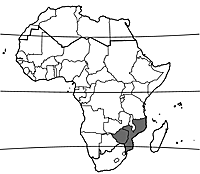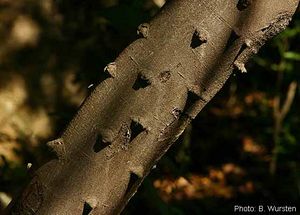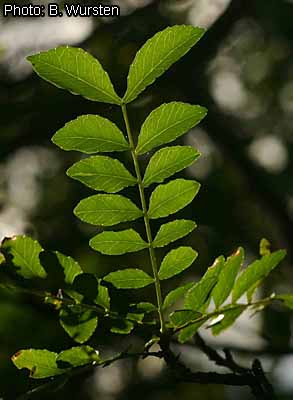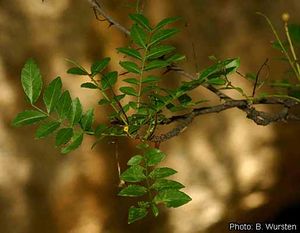Zanthoxylum capense (PROTA)
Introduction |
| General importance | |
| Geographic coverage Africa | |
| Geographic coverage World | |
| Fruit | |
| Medicinal | |
| Timber | |
| Ornamental | |
| Fibre | |
| Food security | |
Zanthoxylum capense (Thunb.) Harv.
- Protologue: Fl. cap. 1: 446 (1860).
- Family: Rutaceae
Synonyms
- Fagara capensis Thunb. (1807).
Vernacular names
- Small knobwood (En).
- Zantoxilo do Cabo (Po).
Origin and geographic distribution
Zanthoxylum capense occurs in Zimbabwe, Mozambique and eastern and southern South Africa.
Uses
In Zimbabwe and South Africa ground stem bark or leaves are commonly used as a snakebite remedy either as an oral medicine or as a local application to the wound. The root bark or stem bark is chewed as a mouth wash to treat mouth ulcers and to treat toothache; ground stem bark or root bark is applied to aching teeth or as a wound dressing. A root infusion is taken to treat infertility and male impotence. A leaf or fruit infusion is taken to treat syphilis, gastro-intestinal disorders and internal parasites. An infusion of the stem bark is taken as a tonic and to treat epilepsy. A root or leaf decoction or infusion is commonly taken to treat colds, fever, influenza, cough, pleurisy and bronchitis. Root powder is eaten to treat blood poisoning and skin impurities. Pounded roots are also applied as a paste to the skin to treat skin problems. Smoke of the burnt plant is inhaled to treat dizziness. The acrid fruit leaves a persistent burning sensation in the mouth when chewed. They are taken to treat colic, flatulence and paralysis (palsy). Grounded stem or root bark is also rubbed into scarifications to treat paralyzed legs. The ground bark is given to cattle to treat gall-sickness.
Young twigs are used as toothbrushes. The hard yellow wood is used in making implements (handles, yokes and planks).
Production and international trade
The stem bark and root bark are commonly sold in local markets.
Properties
From the twigs, stems and leaves the aliphatic amide pellitorine, β-sitosterol, and sitosterol-β-D-glucoside were isolated. From the stem bark and root bark the furoquinoline alkaloid skimmianine and the benzophenanthridine alkaloids chelerythrine and nitidine were also isolated. The stem bark further contains the quaternary tetrahydroprotoberberine alkaloid N-methyltetrahydropalmatine. The stem bark and root bark contain the lignan sesamin. Different stem bark extracts showed moderate antifungal activity against Cryptococcus neoformans and moderate antibacterial activity against Tannerella forsythensisin, a bacteria associated with periodontis. Different leaf extract showed moderate antibacterial activity against Bacillus subtilis, Escherichia coli, Klebsiella pneumoniae and Staphylococcus aureus and moderate antifungal activity against Candida albicans.
Sesamin has been used as dietary fat-reduction supplement, although no controlled studies on this application have been performed yet. Pellitorine showed significant ovicidal and insecticidal activity against several important agricultural pests, and also against the house mosquito Culex pipiens and the freshwater snail Biophalaria glabratus. Sitosterol-β-D-glucoside showed significant anti-ulcer properties in different tests with rats.
Description
- A small, much branched tree 4–7(–10) m high; bark grey, trunk with many woody, prickle-bearing protuberances; stems sometimes armed with prickles up to c. 8 mm long.
- Leaves alternate, (im)paripinnately compound with (2–)3–8 pairs of leaflets, 4–12 cm long; stipules absent; rachis together with petiole 4–8 cm long, deeply grooved above; leaflets sessile, opposite or alternate, becoming progressively larger from the basal pair upwards to the apical one, apical leaflet commonly aborted, leaflets elliptical to broadly elliptical or obovate, 1–4 cm × 1.2–3 cm, apex obtuse or rounded, base asymmetrical, cuneate, with small auricles, margin slightly toothed, with glandular dots at margins.
- Inflorescence a terminal panicle 2–6 cm long.
- Flowers unisexual, 4-merous, regular; pedicel 0.5–1.5 mm long; sepals ovate, c. 0.5 mm long, persistent in fruit; petals narrowly elliptical, imbricate, 2.7–3.1 mm × 1.1–3 mm; male flowers with 4 stamens, ovary rudimentary; female flowers with 4 staminodes inserted at the base of a stout gynophore, ovary glabrous, ovoid, conspicuously dotted with glands, 1-locular, 2-ovulate, style c. 0.8 mm long; stigma discoid, black.
- Fruit a globose follicle, 4–5 mm in diameter, brownish red to orange-brown, 2-seeded.
- Seed black, shiny.
Other botanical information
Zanthoxylum is pantropical and comprises about 200 species, with tropical America being richest in species. Mainland Africa harbours about 35 species, whereas about 5 species are endemic to Madagascar.
Zanthoxylum ovatifoliolatum
Another southern African Zanthoxylum species, from Angola and Namibia, has medicinal uses. In Namibia the Himba people drink a fruit or seed decoction of Zanthoxylum ovatifoliolatum (Engl.) Finkelstein to treat stomach problems. It is also given to domestic animals. The Topnaar people take a fruit decoction to treat sore throats. Seeds are chewed for the same problem. The fragrant powdered dry fruits and seeds are used as body perfume.
Ecology
Zanthoxylum capense is common in dry woodland or bush on sandy soils and in rocky localities, from sea-level up to 2000 m altitude. It flowers in January and fruits between February and May. It is highly variable, with small- and large-leaved forms, especially in juvenile shoots, suckers and coppiced specimens. It is often confused with Clausena anisata (Willd.) Hook.f. ex Benth.
Propagation and planting
The seeds of Zanthoxylum capense are primarily dispersed by monkeys. The seeds do not germinate easily and it is best grown from seedlings collected from under the tree.
Diseases and pests
Zanthoxylum capense is a host of the citrus psylla Trioza erytreae (Homoptera).
Genetic resources
As Zanthoxylum capense is common in its area of distribution, it is not likely to be threatened by genetic erosion.
Prospects
The stem bark, root bark and leaves of Zanthoxylum capense contain several biological interesting compounds, including sitosterol-β-D-glucoside and the alkaloid pellitorine. It therefore merits further research into its pharmacology; its safety profile needs to be established as well.
Major references
- Buwa, L.V. & Van Staden, J., 2006. Antibacterial and antifungal activity of traditional medicinal plants used against venereal diseases in South Africa. Journal of Ethnopharmacology 103(1): 139–142.
- Mendonça, F.A., 1963. Rutaceae. In: Exell, A.W., Fernandes, A. & Wild, H. (Editors). Flora Zambesiaca. Volume 2, part 1. Crown Agents for Oversea Governments and Administrations, London, United Kingdom. pp. 180–210.
- Mokoka, T.A., McGaw, L.J. & Eloff, J.N., 2010. Antifungal efficacy of ten selected South African plant species against Cryptococcus neoformans. Pharmaceutical Biology 48(4): 397–404.
- Neuwinger, H.D., 2000. African traditional medicine: a dictionary of plant use and applications. Medpharm Scientific, Stuttgart, Germany. 589 pp.
- van Wyk, B.E., van Oudtshoorn, B. & Gericke, N., 1997. Medicinal plants of South Africa. Briza Publications, Pretoria, South Africa. 304 pp.
Other references
- Amusan, O.O.G., Dlamini, P.S., Msonthi, J.D. & Makhubu, L.P., 2002. Some herbal remedies from Manzini region of Swaziland. Journal of Ethnopharmacology 79: 109–112.
- Calderwood, J.M., Finkelstein, N. & Fish, F., 1970. Constituents of the stem and root barks of Fagara capensis (Thunb.). Phytochemistry 9(3): 675.
- Coates Palgrave, K., 2002. Trees of southern Africa. 3rd Edition. Struik Publishers, Cape Town, South Africa. 1212 pp.
- Fish, F., Waterman, P.G. & Finkelstein, N., 1973. Sesamin from the bark of two African Zanthoxylum species. Phytochemistry 12(10): 2553–2554.
- Grace, O.M., Prendergast, H.D.V., Jäger, A.K. & van Staden, J., 2002. Bark medicines in traditional healthcare in KwaZulu-Natal, South Africa: an inventory. South African Journal of Botany 69(3): 301–363.
- SEPASAL, 2010. Zanthoxylum ovatifoliolatum. [Internet] Survey of Economic Plants for Arid and Semi-Arid Lands (SEPASAL) database. Royal Botanic Gardens, Kew, Richmond, United Kingdom. http://www.kew.org/ ceb/sepasal/. October 2010.
- Steenkamp, V., 2003. Traditional herbal remedies used by South African women for gynaecological complaints. Journal of Ethnopharmacology 86: 97–108.
- Steyn, P.S., van den Heever, J.P., Vosloo, H.C.M. & Ackerman, L.G.J., 1998. Biologically active substances from Zanthoxylum capense (Thunb.) Harv. South African Journal of Science 94(8): 391–393
- Tyiso, S. & Bhat, R.B., 1998. Medicinal plants used for child welfare in the Transkei region of the Eastern Cape (South Africa). Journal of Applied Botany 72(3–4): 92–98.
- Van den Eynden, V., Vernemmen, P. & Van Damme, P., 1992. The ethnobotany of the Topnaar. University of Gent, Belgium. 145 pp.
Author(s)
- E.N. Matu, CTMDR/KEMRI, P.O. Box 54840–00200, Nairobi, Kenya
Correct citation of this article
Matu, E.N., 2011. Zanthoxylum capense (Thunb.) Harv. In: Schmelzer, G.H. & Gurib-Fakim, A. (Editors). PROTA (Plant Resources of Tropical Africa / Ressources végétales de l’Afrique tropicale), Wageningen, Netherlands. Accessed 2 June 2025.
- See the Prota4U database.




